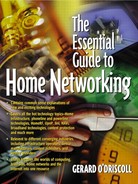A DIGITAL HARMONY ENTERTAINMENT SYSTEM
A typical home entertainment system comprised of Digital Harmony-certified A/V devices is shown in Figure 12.2.
Figure 12.2. A typical Digital Harmony home entertainment system

Digital Harmony systems have the following characteristics useful to consumers:
Digital Harmony system firmware complies with relevant nonproprietary (i.e., open) international standards.
Digital Harmony systems are easy to connect and set up. Each device is connected to another device using a certified IEEE 1394 cable. The connectors are "keyed" so that the cable cannot be connected improperly. There is only one connector type—no more "inputs" and "outputs," no more separate audio, video, and control connectors.
Digital Harmony systems are easy to use via a bidirectional universal remote control that allows the consumer to set up, use, diagnose problems, and upgrade their home entertainment system. The system automatically recognizes new devices and their capabilities, and adds them to the user interface.
Digital Harmony systems are comprised of multiple devices. Each system can have up to 63 IEEE 1394 A/V devices. In addition, larger systems of more than 64,000 devices can be created using industry-standard "bridge" devices that connect multiple busses together. This feature allows cruise ships, hotels, and apartment buildings to operate as a single Digital Harmony entertainment system.
Digital Harmony systems are comprised of devices made by multiple brands. Consumers can choose Digital Harmony-certified devices from many different manufacturers based on features, price, and other personal preferences.
Digital Harmony systems can be comprised of devices found in multiple rooms. Using longer-distance 1394 cables (e.g., Category 5 and optical fiber) and the associated transceivers (to translate standard 1394 copper cable signals into the other cable formats) in the walls of a structure, consumers can have one system with devices physically located in multiple rooms.
Digital Harmony systems can take advantage of non-1394 A/V devices. Consumers do not need to replace equipment in use today. Digital Harmony legacy adapters exist that allow consumers to connect such devices to their system.
Digital Harmony systems can take advantage of pre-Digital Harmony 1394 devices—primarily DV camcorders and computers—in use today.
Digital Harmony-certified devices are backward compatible. A Digital Harmony Composer purchased in 2003 will be able to intelligently control an A/V device purchased in 2000.
Digital Harmony system firmware can be upgraded by the consumer, as new standards are released in the future.
